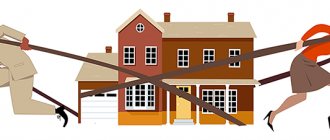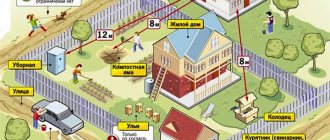To carry out transactions for the purchase and sale of country real estate, the owner orders its assessment. Based on an expert opinion, the real value of the house is determined, taking into account all aspects related to the deterioration of the building. This factor is key and subsequently affects the performance characteristics of the building.
You can determine wear yourself using special algorithms. Use the instructions below to conduct a preliminary assessment of the deterioration of a private home.
Physical wear and tear of structures and buildings - what is it?
Physical deterioration of buildings is a value indicating the degree of deterioration of the technical and other operational characteristics of an object. Over time, any building structure deteriorates in strength, heat and sound insulation properties, water and air tightness, and other indicators that reduce the load-bearing capacity of buildings.
To prevent premature destruction of a structure and extend its service life, it is necessary to periodically inspect buildings and structures for their technical condition.
The best ways to find out the year a house was built
If you have a cadastral number for a property, you can also make a request to Rosreestr or BTI . Each of these authorities provides similar information. To make a request, you will also need a passport and title documents. This information is necessary in almost all real estate transactions, especially when it comes to purchasing an apartment through a mortgage. In a regular purchase and sale agreement, this parameter must be known to correctly determine the market value of the property.
Reasons why buildings wear out
Physical wear and tear of structural elements of buildings or the entire facility as a whole can be caused by the following factors:
- long-term or improper operation of structures;
- abrasion of materials used in finishing or individual structural elements;
- aggressive influence of atmospheric factors causing erosion of the foundation, corrosion and erosion of building materials, freezing of foundations, lateral wind pressure on structures;
- dynamic and mechanical effects leading to uneven settlement;
- biological factors: insects, bacteria, fungi;
- natural disasters: earthquakes, floods, fires, hurricanes and others;
- errors in the design of structures;
- mistakes made during the construction of buildings, for example, incorrect masonry or poor-quality concrete.
Each of these factors causes wear and tear on building structures, but the greatest damage is caused by moisture, as well as vibration acting through the ground.
Reasons
Based on the current legislative norms, the following grounds can be identified that are sufficient to recognize a property as unsuitable for habitation and subject to liquidation:
- A large percentage of wear and tear on the house or its structural components.
- Violation of the integrity of the facility as a result of explosions, fires and other emergency situations.
- Changes in the sanitary parameters of the internal microclimate of the house, which creates a threat to the health and life of residents.
- The location of the property in an area where there is an increased risk of a man-made disaster.
- Placement of the building in close proximity to structures designed to transmit alternating current over a distance.
- Facility windows exit onto the highway with excess noise levels.
- The location of the property in a place with frequent occurrences of natural disasters that can have a destructive impact.
- A property cannot be recognized as unsafe on grounds if it can be eliminated by creating engineering structures or carrying out repair work.
In particular, housing cannot be considered unfit for habitation in the following cases:
- If there is no elevator in a five-story building, provided that it is not fully operational.
- In the absence of a hot water supply and sewerage system in 1- and 2-story buildings.
- In case of any discrepancies between the planned and actual living areas.
The recognition of housing as unsafe and unfit for habitation may not occur completely, but only partially.
Sometimes only a separate part of the house is considered dilapidated, for example, a separate living space due to the emergency condition of the interfloor ceiling.
Types of buildings whose wear and tear is determined
According to the typological classification, all buildings for which indicators of physical deterioration are determined are divided into:
- civilian. This group includes residential buildings (houses, hotels, dormitories) intended for temporary or permanent residence and public buildings - administrative and socio-cultural facilities (schools, hospitals, theaters, shops, clubs and others);
- production Includes industrial workshops and buildings, and agricultural ones (grain and vegetable storage facilities, poultry houses, cowsheds, etc.).
Determining the service life of each of these objects is a rather difficult task, since in addition to various destructive factors, the technical characteristics are also influenced by the nature of the design, the timeliness of the repairs performed and the quality of the materials used, and a number of other criteria.
Free legal assistance
Post-revolutionary houses are characterized by the use of less durable structural elements: lightweight brickwork with warm slag mortar, cinder blocks with low strength characteristics, etc. (service life 100 - 125 years). The peculiarity of the reconstruction of these buildings is to increase the reliability of the main structural elements and the “comfort” of the renovated buildings (exclusion of communal apartments, connection of services, etc.). https://www.math.rsu.ru/build/base/doc/153.ru.txt
Such “tenants” can seriously damage electrical wiring and undermine floors and load-bearing beams.
- Pay attention to how and from what materials the electrical wiring is made, what rating it is designed for. See if the lights in the building are flickering, if there are any other signs of trouble (wires in old insulation, traces of short circuits on distribution boards, etc.).
Stages of wear
There are two stages of physical deterioration of buildings and structures - removable (operational and technical and economic indicators deteriorate) and irreparable (further operation in such conditions is impossible).
The general physical wear and tear of a building during its operation is also divided into phases. Below is a physical wear table with a detailed description of each phase.
| Physical deterioration, % | Assessment of actual condition | Physical wear characteristics |
| 0-20 | good | There are some malfunctions that can be quickly eliminated by repairs. There are no significant deformations or damages |
| 21-40 | Satisfactory | Structural elements are suitable for use, but require minor repairs |
| 41-60 | Unsatisfactory | Only when repairs are carried out is further operation of the facility possible |
| 61-80 | Critical | The load-bearing structures are in disrepair and the building cannot be used without their replacement. |
| 81-100 | Complete destruction | Elements of the structure are severely damaged and cannot be repaired |
How is dilapidated housing different from emergency housing?
The most basic and important difference between dilapidated housing is that there is still no such concept in the legislation. At the end of last year, 2018, the Ministry of Construction proposed to more accurately define what is dilapidated and what is unsafe, however, these amendments have not yet been included in the legislation at the time of writing this article. Moreover, there is still not even a draft (not accepted) version of the definitions, at least in the public domain.
What is important for residents is that dilapidated housing (one that is not new, but not yet in disrepair) is not subject to resettlement. Thus, you don’t even have to try to prove that the house is actually dilapidated. But it is quite possible to prove that the house is unsafe.
Housing recognized as unsafe is subject to resettlement. Also, owners of such real estate can count on compensation instead of resettlement. And in the near future, it is expected that other, additional mechanisms will appear, within the framework of which owners of emergency housing will have even more options and opportunities in addition to those already listed above.
Signs of wear
The following signs of physical wear indicate a change in the operational properties of a building structure:
- chips, cracks, potholes, loss of individual stones from the walls, the above-ground part of the base and foundation pillars;
- bulging and distortions of the base;
- distortions of door and window openings;
- settlement of individual sections of walls, curvature of their horizontal lines;
- violation of the solidity of the masonry;
- peeling and falling off of plaster, weathering of seams;
- cracks in lintels and cornices;
- moistening of wall surfaces, appearance of efflorescence;
- displacement or deflection of plates in relation to one another due to deformations;
- exposure of reinforcement;
- traces of leaks or freezing on the facades.
These are the most common signs by which the wear and tear of building elements is determined. At the same time, attention should be paid to the fact that each structural element of a construction project has its own identification factors.
Housing and communal services news
The tables of Rule No. 446 show signs of wear of individual structures and elements that affect the degree of their wear. The tables allow you to determine the percentage of wear and tear of a house with an accuracy of 5%. They are divided according to the types of materials from which this or that element of the house is made.
BTI also conducts comprehensive inspections of the condition of the house and determines the degree of wear of the apartment building. The frequency of inspections is not established by any legal acts, and is more often initiated by the owners of premises in the house. Such checks are carried out according to the methods set out in Rules No. 446, and are an expert method for determining the degree of wear of the MKD.
Methods for determining physical wear
Calculation of the physical deterioration of buildings as a whole is the most important criterion for influencing the result of the actual assessment of the value of the object. To calculate the assessment of a real estate object, various methods are used, with the help of which the physical deterioration of structures is determined as a percentage.
Cost compensation methodology
According to this method, the percentage of physical wear and tear is equal to the costs that will be required to eliminate defects. The advantage of the method is the ability to substantiate the economic essence of the amount of total wear and tear.
Among the shortcomings are the difficulties that arise when determining the scope of repair work. It is extremely difficult to calculate the wear of the foundation and other technically complex elements.
Due to the fact that the technique is quite complicated to use, it is used, as a rule, for large objects that require determination of the physical deterioration of the building.
Chronological age method
The physical wear and tear of civil buildings or residential structures using this method is determined as the quotient obtained by dividing the chronological age of an object by its service life using the formula:
Bx – actual age of the object under study
Vss – standard operating period.
Simplicity of calculations and a minimum of calculated indicators are the main advantages of the method. But there are also disadvantages. This formula is unsuitable in cases where it is necessary to determine the wear and tear of a building with equal periods of chronological and operational age, as well as the impossibility of taking into account the replacement or repair of individual elements.
Effective age method
Assessing the physical deterioration of a building using the effective age method is in demand among specialists due to the fact that with just one arithmetic operation you can perform the necessary calculations using one of the formula options:
Ve – effective age, or in other words, what age the examined object looks like;
Vost – the period that remains until the end of the operational period;
Vss – standard operating life.
A significant disadvantage is that it is almost impossible for an appraiser to justify the value of Vost (based on the lifespan until the end of operation), since no one can say exactly how long the building will be in operation. An exception is considered the case when at a specific time the object is subject to demolition. Therefore, in practice this lifetime method is almost never used.
Expert method
This method for determining the physical deterioration of buildings is based on a scale of expert assessments, which is set out in full in VSN 53-86r. The value is determined by external damage that can be seen during visual inspection.
The formula for physical wear and tear is as follows:
Иi is the amount of wear of a specific i-element (the indicator is stable and is taken from the corresponding tables);
УВi – specific gravity of the studied i-th element of the object;
i – element number.
The advantages of the method include:
- ease of calculations;
- evidence of calculation data established by current regulatory documents.
There are also disadvantages:
- calculation results are obtained with deviations in the range of ±5%;
- The accuracy of the result directly depends on the experience of the appraiser. It also often happens that significant signs of wear are simply hidden under cosmetic repairs and, as a result, the amount of wear is greatly underestimated;
- influence of the subjective factor. For example, the description in regulations of the amount of wear for a “central heating system” corresponds to the value “drip leaks in heating devices, corrosion of pipelines, poor operation of air heaters” and the percentage of wear in this case ranges from 41 to 60. It is not at all determined how much is 5 or more heating devices should have these “drip leaks” and how to correctly assess the technical condition of the heating system.
In general, if we compare all the positive and negative aspects of the method, the first ones significantly outweigh, which is why it is used very often by appraisers.
Breakdown method
Provides for the calculation of wear and tear of an object while simultaneously taking into account the possibility of its elimination, in particular:
- deferred repairs or correctable wear and tear;
- irreparable wear and tear, when worn-out elements cannot be replaced or repaired due to their short service life;
- irreparable wear and tear, in which only when reconstructing or overhauling an object can worn-out elements with a long service life be restored.
The advantage of this method is the ability to take into account not only visible, but also hidden factors affecting wear. If there is no reliable information about the volume of repairs, then the method cannot be applied in such cases.
Differences between dilapidated and emergency housing (table)
Understanding the characteristics of dilapidated and dangerous buildings, it is interesting to find out what is included in the definitions of both concepts:
- Dilapidated housing is a condition of a house in which the structure is worn out, but the load-bearing elements remain strong. Dilapidated buildings are still stable, but the operation of the structure is in question. The percentage of wear can be up to 70% for stone houses or up to 65% for wooden buildings, for example, attics and private buildings.
- Emergency housing is objects with complete or partial destruction of the foundation, load-bearing walls, roof and other elements of the building. The main problem with such structures is the risk to human life and health. The higher the likelihood of a house collapsing, the more dangerous it is to be in it. Wear can reach from 70-80 and even up to 90% of the structure.
The difference between the two states is expressed not only in their definition. Let's look at the differences between dilapidated and emergency housing in the table:
| Comparison object | Dilapidated | Emergency |
| Concept | The term “dilapidated housing” was used in the laws of the RSFSR - there is no such concept in Russian legislation */ - the definition of “dilapidated housing” is found in only one unofficial source called “Methodological manual for the maintenance and repair of housing stock. MDK 2-04.2004" | Enshrined at the federal and regional levels, the main points of the program for resettlement from emergency housing and the Federal laws of the Russian Federation |
| Demolition, reconstruction, major renovation of a house | Dilapidated buildings are not subject to demolition, because from a sustainability point of view, the building does not yet pose a threat to residents. But dilapidated houses are included in the regional capital repair and reconstruction programs - at the expense of funds from the state budget | Immediate demolition of the house is the only measure regarding emergency housing. Overhaul is meaningless in its essence, because... wear and tear affected the foundation, load-bearing walls and roof |
| Relocation of residents | Resettlement of dilapidated apartment buildings is possible only in one case - if the property is undergoing major repairs (reconstruction). Sometimes a dilapidated house is demolished - in this case, the residents are also relocated to another place | Mandatory stage in the framework of recognizing a house as unsafe and subject to demolition |
| New apartments | Residents of dilapidated but habitable houses do not receive new apartments. However, in the event of relocation due to major renovations, residents will be allocated temporary apartments from the local administration’s reserve housing stock | IDPs from dilapidated buildings receive free apartments in comfortable living space. These could be new buildings or objects on the secondary housing market - the issue is resolved at the level of municipal authorities. The basic principle of “meter by meter” is moving into housing no smaller in size than it was before. If there are not enough square meters, the authorities will pay extra for the missing footage. Minimum area per person – 18 m² or equivalent to a living room |
| Financial compensation | – | If you wish, you can not apply for new housing, but replace it with compensation. The principle is simple - the authorities compensate the market value of the purchased space of the owner in a dilapidated building. The amount also includes the costs of moving, renting another living space, transporting personal belongings, etc. |
| Privatization | If the housing is not recognized as unsafe, the tenant and his family members can apply for privatization. Further, everything depends on the decision of local authorities. In case of refusal, you can appeal it in court | A direct ban on the privatization of emergency housing (Article 4 of Federal Law No. 1541-1 “On Privatization...” dated July 4, 1991) |
| Buy/Sell | Finding a buyer for emergency housing is quite difficult. But if the owner reaches an agreement with the buyer, the sale of dilapidated housing is not prohibited by law | Serious restrictions, and often a ban on the sale of apartments in a dilapidated building. The buyer cannot use either a mortgage or maternity capital - and the Pension Fund and banks carefully check the property. The “emergency” status is like a taboo for them |
Evaluation Rules
Departmental building codes establish rules for assessing the physical deterioration of buildings:
- the physical deterioration of residential buildings and structures must be assessed by comparing factors identified during a visual and instrumental examination with the values given in the table of building codes;
- if a separate structural element or an entire object has signs of wear corresponding to a specific range of values, then it is necessary to take the value that is equal to the upper value of this interval;
- when only one of the signs of wear indicated in the table is found in the structure, then in this case the value should be equal to the lower limit of the interval;
- when only one sign from the table corresponds to physical wear and tear, then it should be accepted depending on the nature or size of the damage using the principle of interpolation.
It is imperative to take into account that these rules do not apply to assessing the wear and tear of residential buildings, the destruction of which occurred as a result of natural disasters.
If housing is found unsuitable for habitation
There are a large number of residential buildings in the country, living in which is dangerous for humans. In order to recognize an object as unsafe, dilapidated or unfit for habitation, a commission is assembled. Experts decide on further actions regarding the property and decide whether to repair or demolish the building.
If a house is recognized as unsafe and is included in the resettlement program, the owners of apartments in this building can gradually prepare to move. But, if the condition of the house is deplorable, and the house is not recognized as unsafe and the program does not apply to it, the owners of the living space have many questions about their further actions.
Real estate properties located in various cities and towns of the country have been in operation for several decades. Over time, the deterioration of buildings becomes significant; major repairs are required for further use. Often such measures are considered ineffective, and the building is subject to resettlement and demolition.
Real estate objects whose condition is at a critical level are divided into three categories:
- Objects unsuitable for habitation. The basis for declaring a residential premises unfit for habitation is the presence of identified harmful factors in the human environment that do not allow ensuring the safety of life and health of citizens.
- There is currently no concept of “dilapidated housing” in legislation, but the term itself is found in various teaching aids. This category includes buildings that are already significantly worn out, but, nevertheless, the supporting structures of which have retained strength and stability. The condition of these buildings is already close to emergency.
- Housing is considered unsafe if it requires urgent major repairs. After completion of the work, people can live in such houses for some time, but in the near future the building must be occupied and demolished.
The legislation of the Russian Federation only stipulates the concept of uninhabitable housing. Categories of emergency and dilapidated real estate are mentioned in conversations, correspondence, and unofficial documents. It is believed that such houses can be used for some time. In accordance with current legislation, only a separate apartment in a residential building can be recognized as unfit for habitation; a residential building can only be recognized as unsafe, while all apartments in a given building are recognized as unfit for habitation.
Each piece of real estate - apartment, room, residential building - has a unique cadastral number. His fate is decided by a special commission. Accordingly, residents receive official documents and plan their further actions.
Lifespan of residential buildings - types and procedure
Reinforced concrete houses are very sensitive to the timing of major repairs. Those. done at the right time and in the required volumes, it can significantly extend the life of the home. However, if repairs are needed, but for some reason are not carried out, then the buildings begin to rapidly wear out, and after some time the repairs become impractical.
- 150 years for especially capital stone buildings with stone/concrete foundations, brick, monolithic and large-block walls and reinforced concrete floors.
- 125 ice for ordinary stone buildings with stone foundations, brick, large-block and large-panel walls, mixed or reinforced concrete floors, stone on metal beams.
- 100 years in the case of lightweight stone buildings with stone and concrete foundations, lightweight construction of walls made of brick, cinder blocks, etc., floors made of reinforced concrete, wood or stone on metal beams.
- 30 years if the buildings are prefabricated panel, frame, adobe, wood-stone foundations, frame walls, wooden floors.
- 15 years for extremely light residential buildings made of boards and similar low-strength materials.
Series of houses at an address in Moscow
Types of residential buildings in Moscow are divided into four groups: monolithic, panel, block and brick. Monolithic houses usually did not have a series and were built according to an individual project. These are mainly modern buildings. Panel and block buildings most often had a series (standard design) according to which they were built. You can read about panel houses here, and about block houses here. Brick houses were most often built according to individual projects, although some series, such as II-29, for example, were made of brick. Nowadays brick houses are no longer built. The easiest way to find out the type of house at an address in Moscow is on the resource nesprosta.ru. Enter the street of your house and its number. The page that opens will display information about the house at its address in Moscow. In the main house parameters section, opposite the “Series” column, you will see the name you are looking for. In this simple way you can find out the type of house by address, the year the house was built by address and other information. If the column described above says “individual project”, this means that your house does not have a series and was built according to a separate, unique project. Most often this applies to brick and monolithic houses. If your address does not appear on the presented resource, then either the house was built quite recently and it has not yet managed to get into the database, or it does not belong to residential buildings.
Please note => Benefits for working pensioners in the Khabarovsk Territory
How can you find out the year a house was built?
- go to the official website of Rosreestr;
- fill out a request for a technical passport;
- pay the fee no later than a month from the date of sending the request (the state fee will cost 150 rubles);
- send a payment document electronically to Rosreestr;
- wait for a response, that is, a registration certificate, which you will receive by email.
As a rule, when applying for a mortgage loan, commercial banks request information about the construction date of the property. It is possible that such data will be needed by other government agencies, or simply this information will be needed for personal use.











